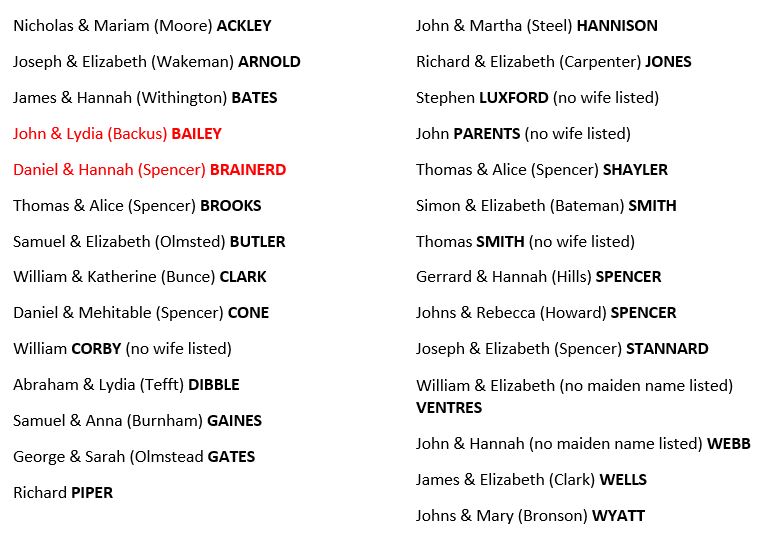Haddam, Connecticut is a town in Middlesex County, and is a quintessential New England town with a rich heritage. It is actually the next town south of Maromas, which is the section of Middletown where Daniel Otis grew up and lived. Maromas is a “stone’s throw” from Haddam.
Twenty-eight men and their families were the first settlers of Haddam. They came from the Hartford, Wethersfield, and Windsor area. The following list was sourced from the Haddam Historical Society.*(see note below). I have highlighted the descendants of Daniel Otis in red.
Daniel Otis descends from the Bailey line (John Bailey and Lydia Backus) and the Brainerd line (Daniel Brainerd and Hannah Spencer); both lines are via Daniel Otis' maternal family. In fact, his maternal grandmother,
Elizabeth Bailey, was from Haddam. She married
William S. Young of Middletown. The genealogical chart below shows the connection of both family lines and how they merged when Ephraim Bailey married Deborah Brainerd.
Here is a wonderful excerpt from the
town of Haddam website, which was written by the Haddam Historical Society. It gives further insight into the early history of Haddam (bold is mine):
“The earliest residents of Haddam were members of Wangunk tribe of Native Americans who hunted, fished and grew corn, beans and tobacco. The Wangunks had numerous settlements in the Haddam area and had relatively peaceful relationships with neighboring tribes.
In 1662 representatives for the Connecticut Colony purchased from the Wangunks the land the English called “Plantation at Thirty Mile Island.” The purchase included 104 square miles and extended six miles inland on both the east and west sides of the Connecticut River and encompassed all of what is now Haddam and East Haddam. The English paid 30 coats (worth approximately $100) for the land and reserved Thirty Mile Island for themselves and the right to fish and hunt where they pleased. The name Thirty Mile Island came from the English who thought the island was 30 miles north of the mouth of the Connecticut River. In reality it is only about 17 miles from the Long Island Sound.
In 1668 the town was formally established and named Haddam after the English village of Much Hadham where the family of Connecticut’s first Governor, John Haynes, had an estate. The original settlement was on the west bank of the river in the area of Haddam village and Shailerville today. The early residents were farmers growing rye, corn and grass and raised cattle. The river played an essential part of the town’s existence for the first 200 years providing transportation and income. Shipyards were built along both sides of the river, and many of the small brooks and streams leading into the river provided waterpower for small mills and factories.”
Here is my primitive genealogical chart that I put together in a Word document (had to post it in pieces here):
*
Haddam Historical Society is located within
The Thankful Arnold House Museum at 14 Hayden Hill Road in Haddam. The home is beautifully restored with a Colonial-style herb garden out back. They are one of the best historical societies in the area: organized, serious about history, and many programs. Elizabeth Hart Malloy is the Executive Director, and is extremely knowledgeable and always very helpful. It's well worth the reader's time to pay a visit.
Want more genealogy? See these pages within this site:




